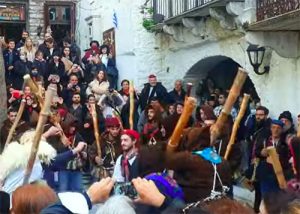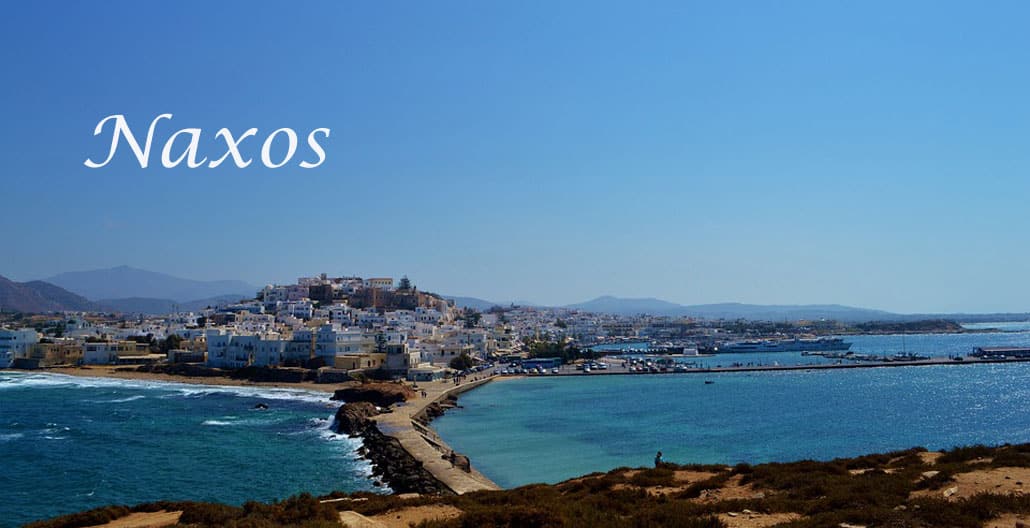Traditions and local customes of Naxos
It is observed that the customs and manners of each place tend to disappear from the modern way of life. But in Naxos, especially the mountainous area, they are still preserved, almost unchanged. The geographical isolation played a part in this as the communication between the villages and the country was done until 1960, with the animals, by paths.
[ez-toc]
Halloween
If anyone happens to be on the island during the Halloween period, they will live a unique experience and a Dionysian feast that culminates in the last weekend, before Ash Monday. Then the whole of Naxos is in an uproar, while in the squares of many villages a feast is set up, with food, plenty of wine and instruments. If someone happens to be on the island during the Halloween season, they will live a unique experience and a Dionysian feast that culminates in the last weekend, before Ash Monday. Then the whole of Naxos is in an uproar, while in the squares of many villages a feast is set up, with food, plenty of wine and instruments.
Koudounatoi Fustanelatoi Cordelatoi

On Ash Monday, mainly in the villages of Livadi, people dress up in dresses or ribbons with colored ribbons and garlands, form groups and dance in the squares
On Ash Monday in Galini, in Egares, in Tripodes and other villages of the island, the custom of Cordelas and Fustanelas is observed. As the scholars of popular tradition report, the ribbons and the fustanellas, during the years of the Venetian rule, were a way for the Orthodox to communicate with each other, while it is said that during the 21st revolution, they sewed triangular handkerchiefs on their chests and there they hid gunpowder to transport it to the Peloponnese and elsewhere.
The custom requires the young people of the village, wearing colored ribbons or foustanelles (white pleated skirts) respectively, to form groups, the “bairakis”, led by the bairakhtari, that is, the one who holds the group’s bairaki, which is a thick stick with a colored scarf on the end, and to honor by visiting the women of the neighboring villages, dancing with them in the central square to the accompaniment of violins and lutes.
In turn, the women of each village treat the men with food, sweets and wine to please them. In fact, in the past, this specific custom was also a way for young people from different villages to get to know each other and thus many marriages took place.
Klidonas
On the evening of June 23, in the villages, the fires of Ai Giannis are lit, where the wreaths of May are burned. Young people and children jump the fire, times each. In general, Klidonas is celebrated with a large participation of young people and ends in a feast with songs and dances in the village square. Fire has a deterrent and cathartic power as it chases away demons and disease and prevents all evil. On the evening of June 23, in the villages, the fires of Ai Giannis are lit, where the wreaths of May are burned. Youths and children jump the fire, three times each. In general, Klidonas is celebrated with a large participation of young people and ends in a feast with songs and dances in the village square. Fire has a deterrent and cathartic power as it chases away demons and disease and prevents all evil.
May Day
On May Day it is customary for people to go to the neighboring countryside and collect flowers. With these flowers they make a wreath, the so-called “May”, which hangs on the doors of the houses. On May Day, it is customary for people to go to the neighboring countryside and pick flowers. With these flowers they make a wreath, the so-called “May”, which hangs on the doors of the houses.
Harvest
The harvest on the island, at the beginning of autumn, is a period of effervescence. The barrels are washed, men, women and children pour into the vines to gather the precious fruit. This is followed by the pressing of the grapes in the “Linos” (press). The must goes into the barrels to boil and become the wine, the “pausilipo wine”. The chambouras (pressed grapes) that remain in the wine press are not thrown away. With these they make raki, an essential companion in the cold of winter.
The Feast of the Fisherman in Apollonas
Every year on the 28th of June in Apollonas village the Fisherman’s Festival is organized, where in addition to the residents of the village, visitors from Komiaki, the surrounding villages and also from the rest of Naxos participate. The celebration begins with vespers at the church of Agios Ioannis, followed by a blessing of the waters and the boats, and then a festival with live traditional music featuring some of the best musicians of Naxos. The table has mainly fish and seafood, the wine flows abundantly and the feast usually lasts until the morning.
Torchbearers
Among the top events are the Torch Relays. Starting from the Venetian Castle, the interested torchbearers, carrying a white sheet with them, gather at the Ursuline School. There the dressing and painting process begins and then they receive the torch completing the outfit. After everyone is ready, the custom begins: a sea of people, dressed in white sheets and painted faces, starts the procession to the beach. Accompanied by drum sounds, and keeping torches burning, they create a fantastic atmosphere.
Rakitzia
At the end of September, the process of distilling the raki, which is known to the residents of the region as rakijo, begins. The preparation of raki is an important event for the inhabitants of the island’s settlements who gather and dance to the sounds of live traditional music.
The tsambouras are placed in a special vessel, the harani, and with the help of fire they are distilled into raki. Acquaintances, friends and passers-by gather at rakitzias to try the new raki.
The Potato Festival
Another famous product of the island is the famous potato of Naxos. Thus, every August the famous “Potato Festival” takes place in Agia Anna in Kapares, Naxos. Every year thousands of people of all ages, locals and visitors taste the delicious Naxos potato cooked with love and imagination, drink local wine, feast and dance to the sounds of traditional music in a celebration dedicated to this local product.
Dimitria
Another celebration of local products is the “Dimitria”, which takes place every year in the first week of August, in the beautiful hinterland of the island, in a traditional village also called the “mystery of the Cyclades”, in Sagri.
They mainly include agro-tourism stands where the visitor can try up close the products produced by the land of Naxia. Events such as concerts and theater performances take place in the forecourt of a monastery built in the 17th century, Agios Eleftherios, while an exhibition of paintings by renowned artists takes place inside.
